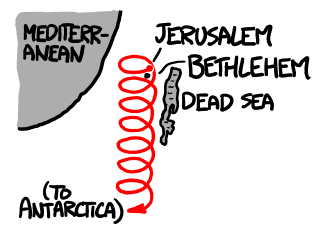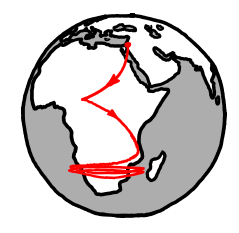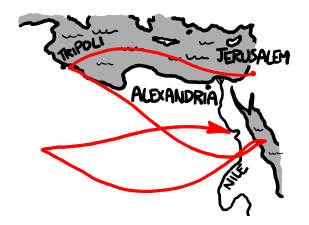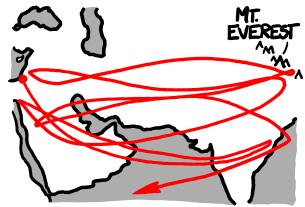In the previous post I commented that this idea of trying to follow a star to get anywhere (say, Bethlehem) would lead to problems. Some years ago I had pointed out that trying to do that would send them around in circles: since the earth is not “fixed” — it rotates and is in orbit around the sun — stars are never in the same place in the sky, so “following” one would take you all over the place.
After posting on that, I found a hilarious illustration of what would happen if the wisemen followed a celestial body to find Jesus. I have borrowed this (no permission required, only acknowledgment) from here: http://what-if.xkcd.com/25/
Acknowledgement is here: http://xkcd.com/license.html
******************************
Three Wise Men
The story of the three wise men got me wondering: What if you did walk towards a star at a fixed speed? What path would you trace on the Earth? Does it converge to a fixed cycle?
—N. Murdoch
If the wise men leave Jerusalem and walk toward the star Sirius, day and night, even when it’s below the horizon, this is the path they follow over the surface:

If we allow a little theological confusion and assume the wise men can walk on water, they’ll eventually wind up going in an endless circle, 30 kilometers in diameter, around the South Pole.
But let’s be a little more realistic; the wise men are hardly going to walk toward the star while it’s behind the Earth. Let’s assume that they only walk toward the star when it’s in the sky and the Sun has set.
In that case, their path actually takes them through Bethlehem:

If they don’t stop there, after a few years, they wind up orbiting Botswana:

These paths are calculated using, among other things, PyEphem, which provides tools for determining the historical positions of astronomical objects.
It’s tricky to figure out exactly what the wise men would have been following. There aren’t very many good astronomical candidates for the Star of Bethlehem (Chinese records don’t show a supernova at the right time, and none of the other obvious candidates check out) and, furthermore, there’s a lot of historical and theological debate over Jesus’s date of birth (“4 BC” seems to be the closest thing to a historical consensus date). These charts are all calculated for a somewhat arbitrary departure date from Jerusalem of December 25th, 1 AD; different departure days would lead to different paths, but the overall picture would be the same.
What if the wise men followed a planet?
Planets move against the background of stars, so the paths they produce are more complex. Here’s where the Wise Men would’ve gone if they followed Venus:

And here’s their path for Mars:

If the three wise men had a hovercar that could move at highway speed over land and water (it’s in the gnostic gospels somewhere) and decided to follow Venus, they’d take a particularly weird path:

At one point, they wind up near the North Pole in October. There, the Sun and Venus spend months near the horizon, rising and setting, nudging the Magi into a month-long spiral around the pole, a chaotic strange Magi attractor around the North Pole which some argue provides the theological foundation for the story of Santa Claus [citation needed].
Sadly, the three wise men probably weren’t following Venus. It’s one of the most familiar objects in the night sky, and as the late Sir Patrick Moore observed, if the wise men mistook it for a new star, they couldn’t have been very wise.
But maybe they’re wiser than Sir Patrick gives them credit for. After all, if you pick a random star in the sky, point at the horizon, and predict that there’s a baby about to be born in that direction, statistics—and birth rates—are on your side.



Very interesting. The Polynesians navigated by the stars so perhaps the magi were from there.
Also I think many cities are aligned with fixed stars based on there apparent location at certain dates or times of the year.
Even geosynchronous satellites move because they are subject to tidal pull of sun and moon which is called diurnal shift.
In a famous poem about Columbus it says he sailed so far that even the stars lost their course.
This is too funny. 😂
Idle and bored on a 12 hour flight, it made my day. Just what I needed.
THANKS! Will share with other mirthful creatures.
If God created the universe, the stars, the laws that govern ordinary behavior, couldn’t God create a special star for a unique purpose with different behavior?
As a believer, it seems possible.
For believers, there is a first amendment that protects your right to believe anything and preach it. The thing that bothers me is that since the bible says a lot of things that aren’t compatible with known scientific fact–and in particular–as apply to social, economic and culture, how far do you want to carry this belief structure? It most definitely should not be taught as scientific fact and placed academically on the same plain as real science–the conclusions of which are–in an open intellectual atmosphere–subject to pier review, debate an lengthy analysis and discussion.
Others have made the point that such belief structures lead us to everything from the oppression of social and cultural minorities and the belief in such Q-anon ideas as stolen elections and deep state scenarios involving millions of evil and demon influenced people.
This is my belief. Never would I impose it on others.
Apologist: But it was actually not a star, but a powerful divine, angelic light likely emanating from the many hosts of angels rejoicing far above the manger (Luke) that only the chosen shepherds and selected wise men (Matthew) to see (since no one else was recorded to have noticed it) to guide them towards the birthplace.
Bart,
That is about the best defense that I can come up with that almost holds Luke and Matthew together here. Have you heard of any stronger solutions?
OK, great. Why not call it that then?
I learn something new every day on here! Thanks!
Interesting…
But more interesting, is what if that passage were to be litterally true? Then what would appear like a star that is stationary rather than traveling? Normal stars traveling across the heavens was common knowlege a longtime before the first century to the average person.. What would stand out and get attention to the 3 kings or wisemen would be a stationary star..
So obviously such would never be intended to be understood as a “Star” as we understand them, so then “what” was the author intending the Star to be? Was he trying to be literal, or symbolical?
I’m not sure I see anything in the text itself to make it seem that he was using symbolism. There is a heavenly object that is leading the magi to the location of Jesus, and it stops in different places and in the end over his house. Almost certainly he had no ideas how stars work in the sky. Either do I!
With application to this post, but also to so many of your helpful critical observations & offerings, I have just come across this attributed to Thomas Aquinas : “The light of faith makes us see what we believe.” This is held up as some great pearl of wisdom & mainstay of faith-filled vision but yet I think it spells out exactly the point you so often make. It is at once true & pernicious. Under the influence or guise of proclaimed faith evidenced facts can be written off as fake news, & abject lies & nonsense decreed as dogma & the prescribed reality. What do you make of this Thomas Aquinas quote & the issue that it reveals?
Yes, it’s not my approach to knowledge and faith. I don’t think learning is meant to confirm what you already think/believe.
Hi Dr. Ehrman,
As long as we’re critiquing the Bible Stories VS Science, doesn’t the whole bible–both old and new testament promote such ideas as:
a flat earth (old testament references to the four corners of the earth)
pillars that hold up the firmament (which is a word translated roughly into English which in Hebrew is used more than 1000 times for the comment word ‘roof’ in the old testament)
During such stories as Noah’s flood, doesn’t it sound like God is opening windows in heaven–as if they existed in the firmament (roof) covering the earth to which the stars and planets are affixed?
doesn’t Paul refer to the three levels of existence earth, the heavens and hell–below earth? (as if they were flat plains)
Yup, pretty much.
Do Young Earth Creationists believe in a flat earth?
Not the ones that I used to hang around with, but possibly some? many?
Hi AngeloB, I knew a bunch of both old and young earth creationists back in the day when I was temporarily infatuated with Garner Ted Armstrong’s Worldwide Church of God. As I began studying on my own and finding out things from scientists and scholars and pointed out how there are strong indications that in the old testament and even somewhat in the new testament, that ‘flat earth’ references are strongly indicated, they had no answer and they got mad at me.
I would presume that “following a star” means looking at the position of the star as it rises (or sets) and taking that as a guide for your direction.
People in ancient times didn’t have to deal with light pollution like we moderns do, so I’m guessing Luke’s original readers would have been well aware of how stars move in the night sky.
Yeah, maybe so. But then it’s hard to know what it means to say it stopped over the house…
I LOVE IT!!! Why people don’t see that it is much easier to believe that it is a story… What am I saying… I thought it was real for decades. Christianity has some crazy stories. Why was it so easy to believe them as factual? I guess because it was like believing in Santa Claus. One just did. It didn’t require mental understanding… it just required faith in the impossible. But as soon as one admits that it is crazy… faith in the impossible doesn’t work anymore. It only seems to work if you believe it’s “real”. Thank you for posting this… it gave me a good laugh this morning… I needed one!!!
Their next assignment is to determine Jesus’ current position in space relative to the earth. Jesus has been “ascending” for two thousand years but we don’t know in which direction or at what speed. Should be quite a problem to tackle.
I expressed the same opinion when I was a teenager. My late father, a Lutheran minister, once suggested to me that the “star” the wisemen followed wasn’t a singular object, but rather an astrological “sign” based on a a configuration of stars and planets which they interpreted and followed the sign’s “meaning” leading them eventually to Bethlehem. Possible?
It’s an nice idea. But how does the configuration stop over a house? Or a town? Or lead anyone anywhere?
There really is an XKCD for everything
AFAIK there isn’t much debate that Matthew’s Nativity tale is, like Luke’s more poetic alternative, a fable woven from whole cloth to remake Jesus of Nazareth into Jesus of Bethlehem to better correspond with Jewish, Messianic prophecy.
Perhaps Matthew merely took the opportunity to simultaneously provide an oblique acknowledgment of the source of the startlingly close parallels between the teachings of the “Anointed One” and the “Awakened One.”
A young Jesus need not have taken an unlikely, 2500-mile sojourn down the Silk Road if proselytizing missionaries of Buddhism, i.e., “wisemen from the East,” had reached Palestine over the five centuries before his birth.
Doesn’t it makes better sense that “his star” refers to the sun sign in a natal chart that suggested to these foreign astrologers that someone in their own time “has been born king of the Jews”?
The notion that the star “went before them, till it came to rest over the place where the child was” — part of one line in a single verse — sounds to me like a lily-gilding flourish by the author in his fanciful allegory explicating how it was that a Jewish Messiah came to hold and espouse manifestly Buddhist precepts.
— cont. —
Is there anything in Torah instructing the Children of Israel to eschew ALL worldly attachments, up to and including gainful employment, home and property, wife and children? Did the frequently genocidal Yahweh anywhere tell the Chosen People that they must not only love their neighbor, but their enemy, as well?
AFAIK those ideas are utterly antithetical to the 1st-century animal-sacrifice cults of the west — arguably, first and foremost, Judaism — but axiomatic to the Buddhist philosophy that was then spreading across the world (though it appears more successfully eastward.)
Wouldn’t all the time and effort calculating convoluted routes that “wisemen from the East” took in the final leg of their journey — based BTW *entirely* on the fanciful Mt 2:9 — be better invested exploring how it was that fundamental, Buddhist precepts ended up on the lips of a Jewish Messiah?
The alleged pursuit of a wandering star IMHO sounds about as wise as creeping around a cow shed at 2 o’clock in the morning. 😉
The soft chirping of crickets suggests you regard as untenable my hypothesis that Matthew’s “wisemen from the east” might have been an oblique homage to the influence of Buddhist missionary/sages on the teachings of Jesus.
Although I am fairly confident of my familiarity with all that survives of Jesus’ actual words (per the red letters in English translations, that is), I freely acknowledge the depth of my ignorance WRT the rest of the Bible — not to mention the patristic writings.
IMHO the quest of the historical Jesus is scarcely furthered by anything beyond the five, surviving gospels since AFAIK (and please correct me if I err here) all else is the work of apologists who probably never even heard of — much less actually heard — Jesus during his ministry. In any case these texts include few ascriptions, all but one (Acts 20:35) merely attesting quotes we already have in the gospels.
My ignorance of Jewish history and legend (even just within the OT) could fill volumes. The deficit becomes wider still for the sutras that purport to preserve the authentic teachings of the Buddha (which are BTW at even greater remove than are the gospels from those of Jesus.)
— cont. —
Ha! The sounds of silence. Yes, I’d say there is nothing to suggest the magi were Buddhist monks ( 🙂 ), but also that there is no evidence early on, or historically satisfying reason to think, that buddhists had any influence on the Christain movement in its early decades or, for that matter, centruies. The authors were deeply familiar with the Jewish traditiona nd influence by Greek and Roman traditions, but nothing Buddhist at this point.
Why Matthew put “wisemen from the east” into his Nativity story is undoubtedly a secret the author took to his grave, leaving a “historically satisfying reason” the best we can hope for.
After eventually realizing that the spiritual “Way” of Jesus was utterly alien to Judeo-Christian tradition, I made the heretical leap of considering the teachings of the also widely-venerated Buddha as a potential source of additional illumination. (How could it be worse? “Buddha! Buddha! Buddha!” 😉)
Siddhartha Gautama, of course, emerged from Hinduism rather than Judaism. His public ministry was fifty times longer than that of Jesus, so his insights (likewise, initially preserved only in oral tradition) were far more extensive and wide-ranging.
But it appears the most noteworthy difference between them is that the Messiah spoke frequently on the imminent “Kingdom of God,” whereas the Buddha was reluctant to speculate on any ineffable eventualities — whether in this world or the next — focusing almost exclusively on how one could eliminate suffering and find happiness in the here and now.
He did emphasize, however, that the only beneficial path through this life would also lead (albeit over numerous lifetimes) to a progressively better afterlife and, ultimately, Nirvana/Heaven.
Any objections so far?
Not sure! I’d say they have very different messages delivered in very different contexts to audiences with very differentassumptions about most everything. But keep on!
No question the differences in contexts, audiences and assumptions could hardly be more sweeping or fundamental.
Jesus emerged from Judaism, the Buddha from Hinduism. The purpose of Jesus’ ministry was to prepare people for the coming Kingdom of God, the Buddha to help them escape the endless cycle of deaths and rebirths. Jesus taught the imminent arrival of an earthly paradise of eternal peace and prosperity, the Buddha an end to suffering in this life and eventual escape to a higher plane of existence.
Followers of both, of course, ultimately cut to the chase and asked the bottomline, $64,000 question: How do I get from here to there? What must I DO to inherit eternal life/escape from samsara?
Despite the obvious and enormous chasm between history’s two, most renowned, spiritual sages — completely disconnected in time and place, culture and theology, having very different metaphysics and undertsandings of the meaning and purpose of life — they, nevertheless, somehow taught the very SAME “Way” to Salvation/Enlightenment!
The very thing I find so confounding is that they DIDN’T have “very different messages.” The “Annonted One” and the “Awakened One” in fact gave the same answer. (In TWO parts! 😳)
Theology in 1st century was plainly more sophisticated in the east than among the animal-sacrifice cults that still held sway in the west.
But admonitions to 1.) Renounce ALL attachments to home, family and livelihood for a beggar’s life, and 2.) Have such unqualified love and compassion for *everyone* else as to respond to a face-slapping by turning the other cheek, would be hard sell in ANY time or place.
Believers in a higher plane of existence will likely concede that this spiritual path *will* lead to salvation/enlightenment. But it is so completely antithetical to survival in our current, tangible circumstance that it isn’t only rich, young rulers who are “deeply dismayed by these words.” Indeed, pretty much everyone will “walk away grieving.”
Speculation that Jesus must have gotten these very counterintuitive ideas by having spent his “missing years” studying somewhere down the Silk Road is understandable. But it seems more plausible that apostles of the Buddha had brought them to Judea over the five centuries before Jesus’ birth.
I can attribute this startling cosnonace to both sages having had the same divine source of inspiration. But aside from a (literally) incredible coincidnece, what other explanation is available to the atheist/agnostic?
If it seems plausible you would need some evidence. But if you’re asking how it is that two people living at different times in different countries and different socio-cultural-religious contexts could come up with analogous ideas, I would say it happens all the time, especially in the history of religion.
Given the separation in time/place/culture between them, it is more than a little startling that both sages, nevertheless, gave their followers the very SAME, two admonitions: First, eschew ALL worldly attachments — including home and family, gainful employment, and any personal possessions beyond the clothes on your back and a begging bowl to get your (quite literally) “daily bread,” and, second, have unconditional love and compassion for all, both neighbor and enemy alike.
Yahweh was caprcious, vindictive and genocidal. Aren’t the teachings of Jesus/Buddha inescably antithetical to the nature and agenda of the god of the Jews?
I have no hesitation crediting the uncanny concurrence on the (strikingly counterintuitive) teachings of history’s two most renonwed preachers to divine consanguinity. But that explanation is obviously inadmissable to the agnostic/atheist.
There is AFAIK no dispute among scholars that apostles of the Awakened One had been spreading his “Good News” for several centuries before the birth of the Annointed One.
Why isn’t Matthew’s “wisemen from the east” as a subtle homage to Buddhist influence having reached Palestine by the year 0 (had there been a year 0 😏) a “historically satisfying reason” for the highly imporbable parallels between the teachings of Jesus and the Buddha?
You’d have to find some evidence that there were historical connections that could get knowledge of Buddhism to Matthew; I dn’t think Matthew was in Israel, so… is there some plausbie connection? And if so, why doesnt the passage about the wisemen say anything or even hint anything about the reliigious views?
Granting, for the sake of argument, this mapmaker’s supposition that Matthew’s “wisemen from the east” is, at least, an allusion to something with *some* historical basis, wasn’t the art/science of astrology frowned upon by Yahweh?
I note that Herod’s advisors did not contest (or even comment on) the astrological data or the magi interpretation of it, but merely cited Jewish prophecy as potential confirmation.
For less fastidious, foreign practitioners of this arcane art, however, wouldn’t the “we observed his star” claim surely refer to a natal chart?
While astrology is another subject with which I am largely unacquainted, IIRC any vagabond, celestial phenomena (i.e., comets) are, to be sure, of great significance. But I believe the appearance of these was always considered an ominous portent.
Are you willing to at least grant that “we observed his star” would certainly have referred to a natal chart, and not some mysteriously wandering “star of wonder” (that, as you note, could not possibly have somehow “stopped over the place where the child was” in any case)?
There’s really nothing to suggest the account is historical, but in any event the author is not thinking of astrology per se, but of the fulfillment of Numbers 24:17 — a one time event, not a practice of astrology. disabledupes{97fc92c280020a0688613c7beecc7361}disabledupes
Indeed, the author’s obvious unfamiliarity with rudimentary astrology suggests the account could NOT be historical.
In claiming that the star “went ahead of them,” Matthew ironically betrays his own ignorance of the very astrological vehicle he chose to carry his tale — even before adding the self-evident incomprehensibility of “it stopped over the place where the child was.”
To card-carrying astrologers the appearance of a new and “wandering” star (actually, a comet) *always* portends disaster — the very etymology, in fact, of that word!
Had this been what the magi observed, it would have been an ominous sign that would have given Herod more immediate concerns, as it would signify the impending DEATH, not birth, of a king! (Though that interpretation would shortly, likewise, prove correct. 😏)
Unsubtle, prophetic retrofit aside, your inference that “the author is not thinking about astrology per se” is entirely justified. Even this untrained stargazer can divine that the author doesn’t actually *know* anything about the astrology.
Nevertheless and notwithstanding,“wisemen from the east” is not something Matthew just pulled out of a wizard’s hat. Doesn’t so lengthy and detailed — not to mention unnecessary — an embellishment suggest that he must have intended *some* kind of historical allusion?
It was widely thought that wisdom came “from the East” or “from Egypt,” and so Matthew is simply following a widely used trope.
Thanks for your patient sufferance, professor. I will not test it further WRT the (inept) astrology that supposedly inspired Matthew’s magi to come in search of “the one who has been born king of the Jews.”
I assume you’d agree that writers of fiction, constrained only by the limits of their own imagination, necessarily have *some* purpose behind every detail, much less anecdote, they include in their stories.
However, I also appreciate that you OTOH are constrained by the limits of historical rigor and cannot be persuaded to engage in speculation unsupported by textual evidence (Is 1:18 premise notwithstanding 😏).
Is there anything in patristic or other Christian analyses documenting Matthew’s “wisemen from the east”? Or for any willing to take the story as allegorical, interpreting what the author had in mind by including this peculiar tale?
Also, much has been made of the mysterious star that “led” the magi to Judea (even hypothetical mapmaking of their route!) But I don’t recall any analyses of the — equally mysterious — gifts they presented.
Gold, frankincense and myrrh are such bewildering presents for a child (they could actually forget about the myrrh next time… 😉) that these must have been symbolic. But of what?
There certainly were patristic discussions of the passage, but I don’t have any specific ones in my head. Often it was pointed out that hte passage showed that Christ would be worshiped not only by Jews but by gentiles from other lands. Wise men still seek him, as they say… The gifts are usually explained as referring to important aspects of Christ: gold for a king; frankincense as an offering to a god; and myrhh for one who is to be buried (so, the earthly messiah, the divine son of God, and the one who will die for the sins of the world.)
Given the 20/20 perspective of writing a century later, surely Matthew could have made better kingly-godly-messianic associations for his symbolic “gifts of the Magi.”
Gold is, of course, universally regarded as the most precious thing on earth. Connection with royalty is plausible — but something of a reach. Literary references to gold are usually intended to simply represent wealth. All that glitters does not belong to kings.
Orthodox inferences WRT the symbolic meaning of the other two gifts, however, are IMHO plainly an apologetic overreach.
Being aromatics, frankincense and myrrh were certainly appropriate adjuncts to religious ritual (the former burned in a censer, the latter for ceremonial anointing.) But these rare substances were more generally appreciated for their medicinal value — which, obviously, wouldn’t serve the narrative.
The reason both were then *more* than “worth their weight in gold” is because they are refined from the sap of two species of tree that only grow on the shores of the Gulf Aden, not only some 2500 miles distant from, but due SOUTH of, Bethlehem!
Do apologists think the “wisemen from the east” regifted from their own stash, or that the wandering star led them on a 5,000 mile detour? 😖
Even assuming Mathew wished to make the specific point “that Christ would be worshiped not only by Jews but by gentiles from other lands,” symbolic gifts of “gold for a king; frankincense as an offering to a god; and myrhh for one who is to be buried” could have been presented by *any* foreigners. Greeks or Romans or Egyptians or Babylonians would have been more geographically and historically relevant. Does Matthew’s creative choice to have the gifts borne, not by any familiar gentiles, but by unprecedented “wisemen from the east” carry no implications for what he intended these gifts to represent?
It’s based on teh widespread view that wisdom “comes from the East.”
Please correct me if I err here, professor. But from my amateur understanding of Matthew it appears that:
1. By the time he wrote the Christian movement had already become an (at best, awkward) admixture of Judaism and Platonism.
2. In composing his account he availed himself of the opportunity to amalgamate these two — arguably, incompatible — traditions.
3. Notwithstanding a reputation for being the “most Jewish gospel,” Matthew’s is actually the most overtly hostile (of the synoptics) to Judaism.
This author has gone so far as to concoct far-fetched circumstances (e.g., the appearance of Jacob’s star offspring, per Num 24:17) specifically to retrofit Jewish predictions of their Messiah into his gospel.
Does Matthew find *anything* of value in Judaism beyond the prophetic bona fides — that he is at such pains to note throughout — it provides?
Am I mistaken in some (or all) of this?
If not, how is the purpose of attempting to reconcile Judaism with Platonism served by introducing so unprecedented an element as “wisemen from the east”?
Is the mere fact that there was a “widespread view that wisdom comes from the East” sufficient explanation, given that it is the wisdom of Plato that he actually needed to emphasize?
It’s a complicated question. For one thing, Christianity was never a single thing, for example “a” combination of Judaism and Platonism. In fact, Judaism and Platonism both came in numerous forms. Apart from that, I’d say that it’s pretty difficult to locate anything specifically Platonic in Matthew. It’s one of the truly fascinating Gospels, both because it so vehemently supports Judaism (5:18-20, for openers) and the teachings even of Pharisees (see 23:2-3) — Jesus followrs are to keep the law even beetter than the Jewish leaders. But the leaders themselves are vehemently condemned (e.g., the rest of ch. 23). Again, the magi story doesn’t seem to be determinative of Matthews religoius/philosophical leanings. It is meant to show that the wisest among the gentiles “get it” but the leaders of the jews do not.
The Pharisees appear to have been squirrelly “blind leaders of the blind.” So getting congrats from Jesus on their occasionally stumbling upon the stray walnut are neither unexpected nor unwarranted.
If I’m not testing your patience, professor, allow me to try one, last tack.
AFAIK no one doubts that Jesus first came into public view as what you (diplomatically) characterize as “an associate” of John the Baptist. Given that neither does anyone deny that Jesus was in fact *baptized* by John, I don’t see the need for such circumspection and would forthrightly describe Jesus as having begun as his “disciple.”
In any event, John’s ritual baptism became (and remains) the initiation ceremony for Christianity, as well.
Formal admittance into Buddhism is even simpler. The novitiate need only make the public proclamation: “I take refuge in the Buddha. I take refuge in the Dharma. I take refuge in the Sangha.” Called the “Three Jewels,” these refuges refer to the teacher, the teachings, and the community of believers.
What could be more precious than the incarnation/personification of all ideals? What could be sweeter than the knowledge the teacher brought? What could be more soothing than the companionship of fellow seekers?
[cont]
Searching for evidence to validate metaphorical gifts in a fable is a fool’s errand redoubled. However, the corollary of your observation that history merely attempts to establish what “probably” happened, would be: deducing what the author of a tale *probably* intended.
The Three Jewels upon which Buddhism stands are equally foundational for Christianity — the preciousness of the Buddha/Messiah, the divine redolence of the Dharma/Gospel, the comforting balm of belonging found in the Sangha/Church.
And the razor cuts both ways.
Origen’s assertion — gold representing, not the Messiah, himself, but his kingly status, frankincense, not the Good News he brought, but his religious significance, and myrrh, not the Church of fellow believers, but funereal rites — strikes me as rationalizing retrofit to avoid discordance with Judaic roots.
Wouldn’t symbolic gifts — brought by *wisemen from the east* and bequeathed to the Jesus *at his birth* (i.e., preexisting concepts) — better describe the foundational structure of the movement he would eventually establish?
Personally, I take refuge in the Messiah. I take refuge in the Good News of his teachings. As for the refuge of the church, like Spurgeon, if I could find the perfect one, I’d join it (but then it wouldn’t be perfect anymore. 😉)
Matthew was at pains to take every “in fulfilment of scripture” opportunity for demonstrating Jesus’ bona fides as the prophesied Messiah.
Indeed, it appears the author wasn’t averse to concocting circumstances — and even extended tales like, for instance, his astrologically-challenged “wisemen from the east” — just to tee up some OT citation.
“A star will come out of Jacob” is probably no more of a reach than some of the other connections Matthew makes to Jewish scripture.
But if he had fulfillment of Numbers 24;17 in mind here, how could he possibly have passed up the opportunity to specifically mention it? Or is this simply a popular inference in post hoc apologetics?
Matthew does that kind of thing a lot. He doesn’t *mention* Moses and the exodus, but like Moses Jesus is divinely protected from a raging monarch at birth who wants to kill him, he comes out of Egypt, he goes through the water t show that he is the son of God, he is tempted in the wilderness for 40 days (as opposed to years), and he goes up on the mountain to deliver God’s law.
Question.
Were the Magi (wise men) Zoroastrian priests?
Nothing in the account connects them with either Zoroastrianism or the priesthood (or rules it out). My hunch is that Matthew had never heard of Zoroastrianism though. He’s just writing a mysterious story.